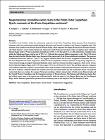| dc.contributor.author | Chew, David | |
| dc.contributor.author | Gawęda, Aleksandra | |
| dc.contributor.author | Golonka, J. | |
| dc.contributor.author | Waśkowska, A. | |
| dc.contributor.author | Szopa, K. | |
| dc.contributor.author | Starzec, K. | |
| dc.contributor.author | Wieczorek, A. | |
| dc.date.accessioned | 2020-01-15T17:04:39Z | |
| dc.date.available | 2020-01-15T17:04:39Z | |
| dc.date.issued | 2019 | |
| dc.date.submitted | 2019 | en |
| dc.identifier.citation | Gawęda, A., Golonka, J., Waśkowska, A., Szopa, K., Chew, D., Starzec, K. & Wieczorek, A., Neoproterozoic crystalline exotic clasts in the Polish Outer Carpathian flysch: remnants of the Proto-Carpathian continent?, International Journal of Earth Sciences, 108, 4, 2019, 1409-1427 | en |
| dc.identifier.other | Y | |
| dc.identifier.uri | https://link.springer.com/article/10.1007%2Fs00531-019-01713-x | |
| dc.identifier.uri | http://hdl.handle.net/2262/91339 | |
| dc.description.abstract | Crystalline exotic boulders within the sedimentary sequences of the Outer Carpathians likely represent Proto-Carpathian basement, which was exposed and eroded during the Mesozoic and Cenozoic evolution of the Western Carpathian basin. The majority of the boulders were derived from the Silesian Ridge, which separated the Magura Basin and the Silesian Domains, and which became a source region during Late Cretaceous–Early Paleocene tectonism. Felsic crystalline clasts within the Silesian Nappe yield U–Pb zircon magmatic protolith ages of 603.7 ± 3.8 Ma and 617.5 ± 5.2 Ma while felsic crystalline clasts within the Subsilesian Nappe yield an age of 565.9 ± 3.1 Ma and thus represent different magmatic cycles. The U–Pb zircon data also imply that the Silesian Ridge was a fragment of the eastern part of the Brunovistulia microcontinent. The presence of inherited zircon cores, dated at 1.3 and 1.7 Ga, suggests a Baltican source for the clasts, as opposed to Gondwana. We infer that Late Neoproterozoic felsic magmatism within the Proto-Carpathian continent represents a long-living magmatic arc, which formed during prolonged Timmanian/Baikalian rather than Pan-African/Cadomian orogenesis. Mafic exotic blocks, found within the Magura Nappe, yield U–Pb zircon ages of 613.3 ± 2.6 Ma and 614.6 ± 2.5 Ma and likely represent a fragment of an obducted ophiolitic sequence. The protolith of these mafic boulders could represent Paleoasian Ocean floor located to the east of Cadomia, obducted during later orogenic processes and incorporated into the accretionary prism. All analysed exotic clasts show no evidence for younger (Variscan) reworking, which is characteristic of both western Brunovistulia and the Central Western Carpathians and the Cadomian elements of Western Europe. The Silesian and Subsilesian basins thus had a likely source area in the eastern part of Brunovistulia, while the source of the Magura Basin was the Fore-Magura Ridge, whose basement potentially represents an accretionary prism on the margin of the East European Craton | en |
| dc.format.extent | 1409-1427 | en |
| dc.language.iso | en | en |
| dc.relation.ispartofseries | International Journal of Earth Sciences; | |
| dc.relation.ispartofseries | 108; | |
| dc.relation.ispartofseries | 4; | |
| dc.rights | Y | en |
| dc.subject | Outer Carpathians | en |
| dc.subject | Brunovistulia | en |
| dc.subject | Exotic blocks | en |
| dc.subject | Neoproterozoic magmatism | en |
| dc.title | Neoproterozoic crystalline exotic clasts in the Polish Outer Carpathian flysch: remnants of the Proto-Carpathian continent? | en |
| dc.type | Journal Article | en |
| dc.contributor.sponsor | Science Foundation Ireland (SFI) | en |
| dc.type.supercollection | scholarly_publications | en |
| dc.type.supercollection | refereed_publications | en |
| dc.identifier.peoplefinderurl | http://people.tcd.ie/chewd | |
| dc.identifier.rssinternalid | 205569 | |
| dc.identifier.doi | http://dx.doi.org/10.1007/s00531-019-01713-x | |
| dc.rights.ecaccessrights | openAccess | |
| dc.contributor.sponsorGrantNumber | 13/RC/2092 | en |
| dc.identifier.orcid_id | 0000-0002-6940-1035 | |




